
© Jacob’s Pillow. (Click image for larger version)
The Jacob’s Pillow website contains an important and incredibly diverse dance archive under the banner “Dance Interactive” – Susanna Sloat introduces an important resource and calls out many video gems…
danceinteractive.jacobspillow.org
www.jacobspillow.org
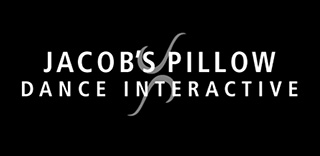
Jacob’s Pillow, the summer dance mecca in southwestern Massachusetts, was founded in the early 1930s by Ted Shawn as a home for his all-male company. After 1940 when Ted Shawn and His Men Dancers disbanded, Shawn stayed on until his death in 1972 at 80, bringing in other companies, teachers, and performers. Jacob’s Pillow was soon welcoming performances by everyone from Ruth St. Denis, Shawn’s former partner in the Denishawn School of Dancing and Related Arts, to Alicia Markova. In the 21st century it hosts a great variety of dance, in normal times a very full season of performances, residencies, a school, and studios full of activity, lately including Covid-era bubbles for creating new work, and videos of that work. It has a website that is complex and confusing, but also valuable for any dance lover to peruse.
My initial foray into the website was brief, checking out from the first page of its Dance Interactive feature digitilized films of a famous piece for Shawn’s men’s company, a solo by Shawn, and one by St. Denis. I felt I was truly getting back in time to an era I had missed. What else did this website have to offer?
I thought about three videos, I had seen elsewhere online that particularly impressed me, because they brought us into an intimate view of masterworks. Each was an enduring piece created by a master choreographer early in a long career, each told a horrifying story with brilliant compression. And each was danced in a fairly shallow field in front of scenery, allowing a close-up view of a sharply videoed performance – ultimately very satisfying.
Balanchine’s 1929 Prodigal Son danced by New York City Ballet with Daniel Ulbricht as an expressively tortured prodigal, his facial emotions visible as they are not in City Ballet’s home theater, also allowed me a closer look at the expressionist choreography for lesser characters like the goons. (Sadly, the recently streamed film is no longer available). With Paul Taylor’s 1970 Big Bertha I marveled at the sheer inventiveness of the movement, varied for each of the four characters as the insidious carnival automaton Big Bertha commands an initially happy family into utter degradation. I found Kurt Jooss’s 1932 The Green Table as danced powerfully by Ballet West truly revelatory. I had seen American Ballet Theatre do it a few years ago, but now, so much closer up, each iteration of the expressionist Death figure as he completes his terrible work had a devastating impact.
Those three films represent online dance viewing at its most impressive. Would Jacob’s Pillow’s Dance Interactive produce the same wonder and chills? No, it turned out and I had misunderstood the site. This was not an archive of complete dances; it was a sampling of many, many pieces, each, often, with just a minute of dance. And as such, it proved in its way irresistible. Once you start, it’s hard to stop.
Dance Interactive
The well-chosen excerpts set up a pace that takes over and can make one impatient with longer video, such as the ones connected to the extensive essays in “Themes/Essays” that are also part of Dance Interactive. These are grouped into “What is Dance,” “Women in Dance,” “Men in Dance,” “Dance and Society,” “Dance of the African Diaspora,”, and “Tap.” There is a wealth of fascinating discussion and reference here. It’s a valuable resource when you have the time to pursue the essays and associated materials.
Dance Interactive is only one part of Jacob’s Pillow’s extensive website; there is much else, including information about Jacob’s Pillow’s wide-ranging Archive, viewable in person, which includes complete videos among all kinds of memorabilia. Just navigating the site takes some investigation, and that includes the ways to get into Dance Interactive that most suit you.
Dance Interactive currently features four very varied playlists (there are plenty of others that will be suggested) that show up prominently on the website, making them a too easy first choice: Indigenous Dance of the Americas (including Native American and Hawaiian), Broadway & Ballroom, Black Artists in the Duke, New in the Duke. But because each video quickly and annoyingly segues into another video, as with YouTube, I found it much better to use the listings by decade, if not so easy to find. Look for the small “Menu” at the top right of the Dance Interactive opening page. “Browse” takes you to the listings by decade. “Menu” also gives access to “Themes/Essays.” When you are “browsing,” you will constantly need to return to the listings “By Era.”
1930 – 1939 videos
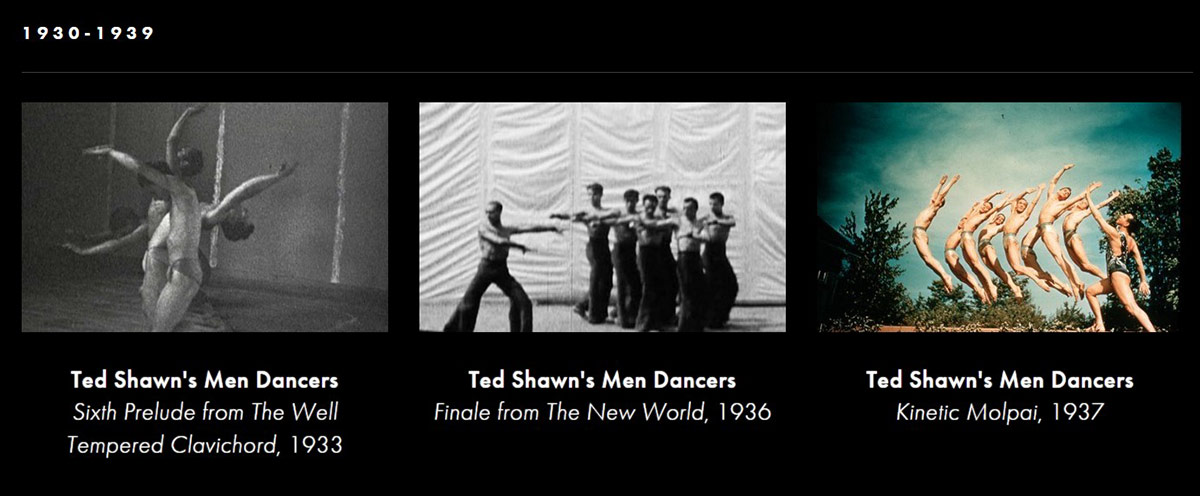
© Jacob’s Pillow. (Click image for larger version)
Jacob’s Pillow in the thirties was home to Ted Shawn and His Men Dancers and all five films from this era are of Shawn’s work. Four are of group work and one is a solo. Kinetic Molpai may be the most famous of Shawn’s works, but here “Mechanized Labor” from Labor Symphony best shows his skill at patterning. Shawn’s dance moves are often stiff. Here he uses that stiffness to suggest rotating and sliding mechanical parts – like pistons and gears. When the men scissor their arms with the black and white parts of their shirtsleeves moving back and forth they effectively look like a precision machine. But that precision dissipates when the men’s circle falls apart and they jump up and collapse in chaos, a machine run amok.
Shawn’s solo is to the spiritual (wordless here) “Nobody Knows the Trouble I’ve Seen,” and he bends in pain, staggers, covers his head and fully bends in more suffering. Shawn and His Men Dancers toured widely in the thirties and had an impact at that time. Today his choreography would not seem to call out for widespread revival, but Jacob’s Pillow is still interested in its founding father and so is Adam H. Weinert who has revived some of Shawn’s dances. Check out the essay in “Men in Dance,” “The Haunting of Adam Weinert by Ted Shawn.” In 2016 Weinert mounted “Trouble” on Davon Rainey, an African American dancer who is, well, a much better dancer than stiff Shawn and injects muscular power and subtlety into the solo and also transforms abjection into a show of strength.
Another essay in “Men in Dance” is “Ted Shawn and The Defense of the Male Dancer” by Paul A. Scolieri, who has written a recent book on Shawn. There are more videos of Shawn’s dances in this essay, reminding us that Dance Interactive with its short videos is just a small part of the rich archives at Jacob’s Pillow. Thinking of Denishawn’s appropriation of exotic cultures, including India, I checked out Shawn’s 1926 solo “The Cosmic Dance of Siva.” Shawn, surrounded by a sculptural circle, ends in the Shiva Nataraja pose with one leg lifted and that’s the best part of the dance. Though he tries to glide his head Indian style, Shawn’s stiff moves and poses on a plinth are not remotely Indian, but as an historic artifact this “Cosmic Dance” is interesting.
1940-1949 videos

© Jacob’s Pillow. (Click image for larger version)
There are a dozen videos for this decade when Jacob’s Pillow welcomed many kinds of dance, from an Iroquois dance by Tom Two Arrows and a brief West African dance by Asadata Dafora to solos by José Limon, Talley Beatty, Anna Duncan (an Isadorable), and Barton Mumaw, Shawn’s disciple and lover, who maintained a lifelong association with the Pillow. There’s lots of ballet – Alicia Markova as the Sugar Plum Fairy (sharply filmed and performed), Alexandra Danilova and Frederic Franklin in an excerpt from Gaité Parisienne, and bits of Jerome Robbins Interplay and Fancy Free. I wanted to watch them all. But I can’t write about them all, so to bookend Shawn’s “Cosmic Dance” let’s look at Ruth St. Denis in “The Delirium of Senses” from her famous Radha.
St. Denis’ 1906 solo dance Radha much proceeded Denishawn (1915-1931), and St. Denis, who was born in 1879, was about sixty-two when this film was made in 1941 at Jacob’s Pillow. She was still a vibrant performer. The film was shot in color and is in sharper shape, with better filming than many of these early vignettes. We see some of the arm moves and snaking handwork that St. Denis was known for. For much of “Delirium” she is whirling, first one way, then the other, her voluminous skirt whirling out. Then she and her skirt fly round and round until she begins manipulating her skirt’s volumes and then falls to the floor. Early in her career she was a skirt dancer in vaudeville.
St. Denis wears a headdress meant to suggest Indian sculpture, but otherwise the dance does not seem Indian, anymore than Shawn’s “Cosmic Dance” does. It’s a stagy piece and the sexagenarian St. Denis carries it off well. She has plenty of presence. She still does in Liebestraum to Liszt (music added later as in all these early films), even if again her emotional presentation seems stagy. It was filmed at the Pillow in 1949. She last performed at Jacob’s Pillow in 1964 and died in 1968.
1950-1959

© Jacob’s Pillow. (Click image for larger version)
There’s a cornucopia of twenty excerpts for this decade on Dance Interactive. Again there is plenty of ballet, with famous names from Maria Tallchief to Tanaquil LeClercq and Alicia Alonso and Erik Bruhn. There’s the National Ballet of Canada in Tudor and Ballet Rambert in Tudor, too. There’s modern dance, including Merce Cunningham and José Limon.
The films are often fuzzy, but there’s much to ponder. I enjoyed getting a glimpse of Alonso’s famous Giselle, and yes she was ethereal and moving, even in a brief excerpt. I was intrigued by Cunningham’s lively jumping in Banjo from 1955, Pearl Primus’ jumping, whirling, falling down energy in Spirituals from 1950, the intense drama of the Limon Company in The Moor’s Pavane, San Francisco Ballet’s interesting version of a part of Balanchine’s Apollo. But I was particularly drawn to Jean Léon Destiné and Jeanne Ramon’s Martinique from 1950.
I knew Destiné much later in his life, but in this short, clear film I can see his youthful, elegant quick stepping and now upright, now slightly or more deeply bent over very Haitian gallantry to his equally elegant partner, Ramon in her 19th century style plaid dress and high white headdress. Martinique is a Haitian folkdance of the countryside that takes off from French set dances, but is also full of Afro-Caribbean inflections of the body that Destiné and Ramon exemplify with every subtle muscle. Watch how they insert changing inflections into his every step over step, the continual incremental rises and falls of her hips and sometimes her shoulders, and her rhythmic skirtwork as she steps and turns.
You can connect to John Perpener’s essay on Destiné which includes parts of an interview with him in 2004, the last time he came to the Pillow. His first visit was in 1949. Later that year Ted Shawn went to Haiti, saw some Vodou ceremonies, and was very impressed by performances of the national folkloric company that Destiné had just organized and the way that he had transferred rituals from Vodou to the stage. In 1951 Shawn wrote about the baptism of a Vodou drum at the Pillow. Destiné was the first person of color to teach at the Pillow, last doing so in 2004. He died in 2013.
1960-1969
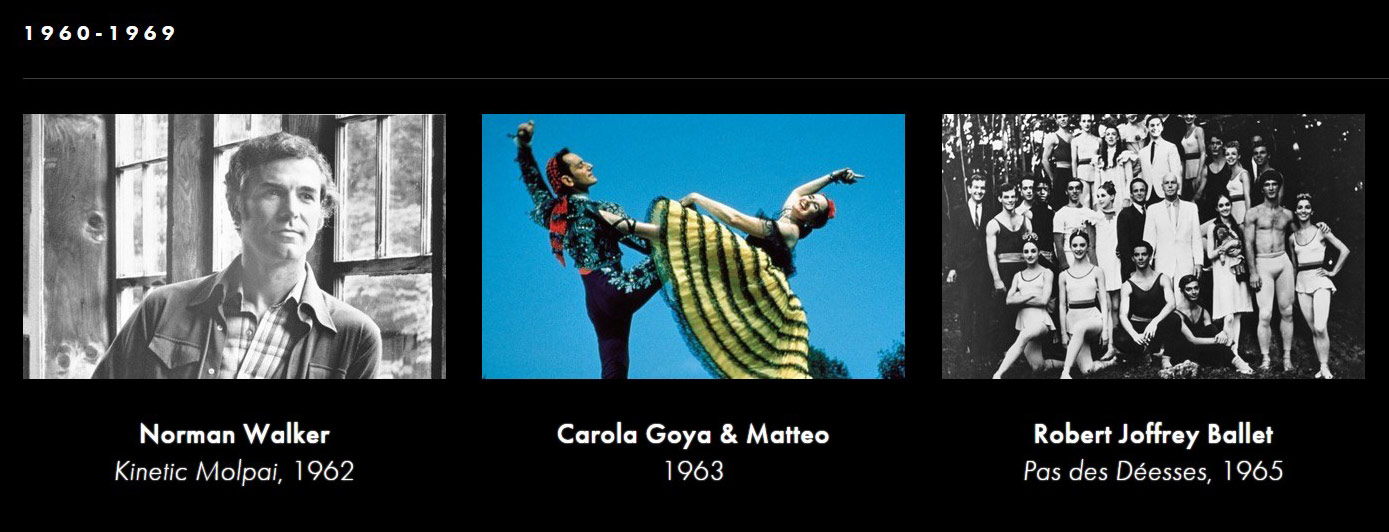
© Jacob’s Pillow. (Click image for larger version)
There are only five items for this decade. Any program to film performances must have been discontinued. We can see a selection from Shawn’s Kinetic Molpai, revived in 1962. The excerpt starts with a group assemblage and continues with a solo by Norman Walker.
Carola Goya and Matteo dance a flamenco duet in synchrony. He’s upright and elegant, she flashes her bata de cola. Robert Joffrey’s Pas des Déesses is gauzy in style and in filming, lovely, but just a snippet. The Center Ballet of Buffalo danced Bronislava Nijinska’s Les Biches at the Pillow; her daughter donated the film. It’s sharply made and offers a succession of brief scenes from the ballet, also sharply made and very intriguing since Nijinska’s choreography is so rarely done.
The most substantial offering is the Grand Pas de Deux from Balanchine’s Nutcracker. It was very well filmed (except for once cutting off the ballerina’s head), and very well danced by two stars of New York City Ballet, Patricia McBride and Edward Villella.
1970-1979
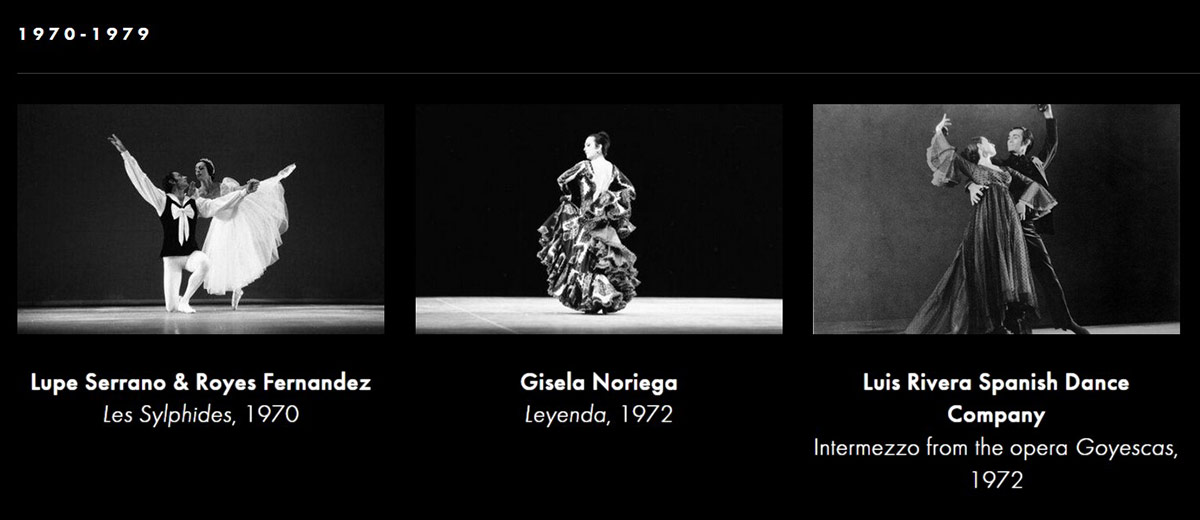
© Jacob’s Pillow. (Click image for larger version)
This decade is also sparsely documented, with six things to watch. We get to see bits of ballet – Lupe Serrano and Royes Fernandez lovely in Les Sylphides, a fuzzy snippet of Spring Waters. A lightly clad couple engage in a gymnastic display in Etude aux Objets. More engaging are two Spanish dance excerpts: a slow solo and duet by Marta Castillo and Luis Rivera to instrumental music from the Granados opera Goyescas, and more castanets and an impressive display of control and presence by Gisela Noriega in her Leyenda. Indrani was charming in a Kuchipudi solo, Tarangam, with Krishna’s flute playing evoked.
1980-1989
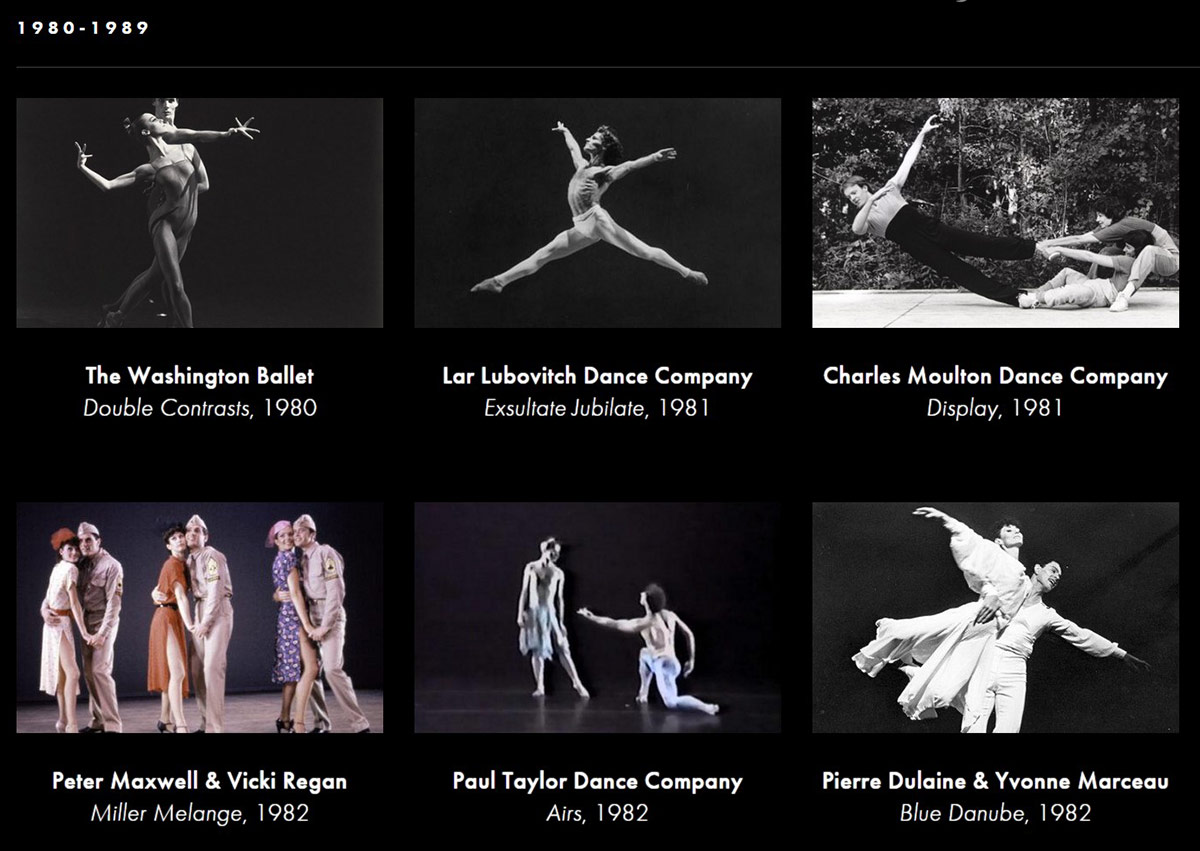
© Jacob’s Pillow. (Click image for larger version)
Now we’re in the era of videoing performances – but not everything. The only time I’ve seen a performance at Jacob’s Pillow was in 1989 when I saw Mark Morris’s company. There’s nothing here from that engagement, but from 1987 there is a video of Morris dancing a solo from his Deck of Cards. There are 48 other videos from the era and a need to strategize what to choose.
You can approach this by zeroing in on the idioms you prefer. But my tastes range too widely to narrow down that easily. And lots more was coming; there were 85 videos in the nineties. In the two 21st century decades there seemed to be too many to count. Now everything is videoed. I expected to find videos from the 620 seat Ted Shawn theater, the newer, smaller, more flexible Doris Duke theater (which burned down in November 2020), studios, and the outdoor stage.
I didn’t jump around. I watched each video in chronological order, knowing there would be many surprises and that this was probably the last decade to do this. New things came to the Pillow: ballroom dance, tapdance, postmodern dance, Irish stepdance, Hawaiian dance, Pilobolus, as well as modern dance and ballet – new ballets were often athletic. Videos, unfortunately, were often blurry. Here are some things that surprised me or made me want to take another look.
I had no idea that in 1982 Les Grands Ballets Canadiens’ Soaring would be a 1920 piece to Schumann choreographed by Doris Humphrey (who, like Martha Graham, came out of Denishawn) and Ruth St. Denis. It’s a gentle piece for five women in white who manipulate a large cloth that billows and changes colors and shapes, sometimes dramatically. Cynthia Gregory in Brahms Waltz was also a surprise – it’s from 1922 and also by Ruth St. Denis. Gregory adds lovely nuances as she sweeps and wafts or swirls her long pale wings, sometimes adding a gentle drama.
In 1983 Bill Irwin clowns and slides into pratfalls, but also dances up a wonderfully slippery-bodied, fast-footed storm in Post-Modern Studies to rapid jazz. Leon Collins was the first tap dancer at the Pillow in 1983, after Ted Shawn’s death, (according to an essay by Brian Seibert in “Tap,” Shawn did not appreciate tap dance). Collins, 61 at the time, tapped elegantly, not to jazz, but to Rimsky-Korsakov.
Blondell Cummings danced He’s Got the Whole World in His Hands, sung by Odetta, on the outside stage in 1984. Cummings uses her own powerful arms and hands in a richly expressive, signaling way, acting out the song. Chicken Soup, her best known piece, is here in 1989, with those strong arms and bending, evocative body, seated before she finally gets up, and then down to scrub the floor, remembering her grandmother in the kitchen.
To Lenny Pickett’s lively, plangent “Borneo Horns” in 1987, Stephen Petronio twists and folds in an imaginative, muscle-shaping way in #3 on the outdoor stage, reminiscent perhaps of his mentor Steve Paxton, but also original. Also outdoors, in 1988, Jean Butler and John Jennings flashed amazingly rapid feet in an expert display of Irish step dancing. That year the Pauliteiros of Cércio in Portugal clashed sticks as they hopped in quick changing patterns, the men attired in fancy hats, layered skirts, and fringed shawls, stick-dancing to bagpipe and drum.
Some surprises are heart-rending. In 1986 Marge Champion dances sweetly with her son Blake, embraced, or swirled around by him. The sidebar tells us that he was killed the following year in an automobile accident at the age of 25.
1990-1999

© Jacob’s Pillow. (Click image for larger version)
I didn’t think I should watch 85 videos, though they are short and it was tempting. But how to pick among the plethora of things I had seen and liked and things I was curious about? I skipped around and found some themes to highlight. One nice prospect: video resolution tends to be much better by the end of the decade.
Urban Bush Women’s Praise House, leads off the videos of the 90s. Its recording is fuzzy, but the choreography by Jawole Willa Jo Zollar and Pat Hall gives us dancing that is sharp, jutting, swerving, and insistently rhythmic to the clapping of hands and tambourines. This is part of a full-length piece about a visionary African American artist and it was co-commissioned by Jacob’s Pillow, which has often been an incubator for dance.
Later in the decade (1998), catch Zollar talking, gesturing, and dancing emphatically in Self-Portrait, which is both passionate and at one moment hilarious about the company she created, Urban Bush Women. Skipping to 2001 you can see Zollar and her company in HairStories, commissioned by the Pillow, an ode to black hair.
Early in her career Zollar was mentored by Dianne McIntyre whose Invincible Flower appears in 1998. The dancers are now synchronized, now dancing individually, comping with shifting, splaying moves. They are surrounded, truly surrounded, by Lester Bowie’s trumpet, a trombonist, and the rest of his terrific jazz band, which combines the polyphonic dancing spirit of New Orleans with Bowie’s Art Ensemble of Chicago avant-gardism. You can see McIntyre, a notable soloist, in the next video, Willow Song.
Another crucial figure for Zollar and McIntyre was Katherine Dunham. In 1996 Cleo Parker Robinson and Randy Brooks slink, shake, and twist to Jess Stacy’s jazz in Dunham’s 1938 Barrelhouse Blues. To continue our thread of significant revivals, this one part of Pillow’s ancestry, the next year Carmen de Lavallade danced a considerably older piece, Ruth St. Denis’ 1906 The Incense. Clad in a sari, she signals with arms and hands before she picks up the incense bowl as an offering.
De Lavallade was in her sixties at the time, but like St. Denis she continued to perform, at the Pillow among other places, in her eighties, in fact all through them. Recently she turned 90.
Among the nineties offerings by actual Indians, 1998’s performance by Malavika Sarukkai of Prakriti Stuti, an homage to the sun, stands out for its crisp, authoritative, rhythmically incisive, and engaging Bharatanatyam. Chandralekha was acclaimed in that style early in her career, but much later became a notable avant-gardist. Her group danced her mesmerizing full-length Yantra in 1994. Get a glimpse of the slow ensemble formations and rhythms here.
Skipping continents to Africa and time to 1993, see Les Guirivoires Solo. Rose Marie Guiraud is the soloist and founder of the company from Cote d’Ivoire. She’s powerful and intense, combining jumps and shifts and stomps with minute isolations of shoulder and hip to djembe rhythms.
Back to Asia in 1997 when Myung Soo Kim is lovely in her slow ritual dancing and a richly layered costume with extended sleeves that she waves and twists, as she dances a courtly and shamanic “Taepyungmu” on the outdoor stage. Qian Yi and Wen Yuhang also dance with graceful extended sleeves as we hear singing in the sixteenth century Chinese opera The Peony Pavilion. This brief excerpt gives an idea of the intensity of connection and beauty of the twenty-four hour opera, which took several days to see fully at Lincoln Center in 1999. Jacob’s Pillow was the home for three months of staging this extraordinary piece.
The nineties selections end with Nina Ananiashvili, then of American Ballet Theatre, and Sergei Filin of the Bolshoi dancing an early piece by Alexei Ratmansky, Charms of Mannerism. To Couperin, it’s Ratmansky in a classical but fresh mode, and the two stars in their elegant black and white costumes wave arms amid crisp classical steps, dancing and partnering with precision and charm. To catch another ballet star, see Mikhail Baryshnikov in 1995 dancing Pergolesi, made for him by Twyla Tharp. He turns and jumps virtuosically, balletically or more in a modern dance way, but also has offhand moments, even a stumble or shake of head or hand designed for laughs to undercut the superstar aura. He does this to perfection.
2000 – 2009

© Jacob’s Pillow. (Click image for larger version)
Going down the rows of five I lost count, but going up I counted twenty-five rows, for 125 excerpts in nice, sharp video. Much to discover – and much I had to skip. Let’s salute four master choreographers, starting in 2000 with Paul Taylor and his Company B to the Andrews Sisters. Andrew Asnes dances “Tico Tico,” combing his hair, shaking his body, stationary or moving swiftly. He barrel turns, rolls on the floor, shifts all kinds of body parts, turns, and cartwheels to triumph.
Slowing down and continuing with another master, watch Garth Fagan’s “Spring Yaounde” from Griot New York with music by Wynton Marsalis in 2008. Norwood Pennewell and Nicolette Depass dance this sensuous, loving duet to a backdrop of sculptor Martin Puryear’s giant spatula. Its curved handle is echoed by curved moves of the dancers, who balance on one leg while dipping their bodies to start. They slowly revolve around to face each other, rolling their faces against each other, embracing and dipping down deeply, before he lifts her up for more face rolls.
The 2009 excerpt from master Merce Cunningham’s 1975 Sounddance begins with a solo and develops interesting complications when more dancers are added. There is a fascination in how the dancers interact in their dippings and bends and arm twists, their back and forth footwork, synchronous turns and movings apart.
Like Cunningham and Taylor, Erick Hawkins shares a distant Denishawn descent through Martha Graham. In 2009, fifteen years after his death, Hawkins’ 1957 Here and Now with Watchers was performed outdoors against a backdrop of trees and mountain. The two dancers carry sculptures, rounds with trailing ribbons and above, wings made of slats. Their movements are mostly slow and deliberate, with precise legs, their relationship mysterious. The landscape background seems perfect for this exploratory piece, which here ends too soon.
I’d like to tell you more about the first decade of our current century, about hiphop, tap, exquisite Indian dance, other choreographers with striking work. But you’ll have to explore on your own. I thought we’d better get on to 2010-2019 with something approaching 250 videos. But after sampling the era and failing to find a theme to harness its riches, I decided, again, to leave exploring up to you.

© Jacob’s Pillow. (Click image for larger version)
My own explorations have led to an even greater desire to see live performances once more. Jacob’s Pillow, after having to cancel the 2020 season because of the Covid pandemic, is anxious to provide that for us and has plans (not yet revealed) for outdoor performances in 2021…












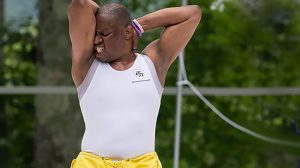

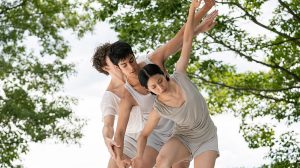
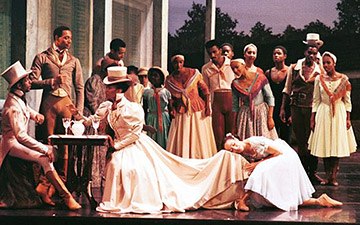

You must be logged in to post a comment.